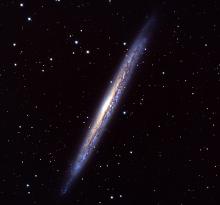Listen to today's episode of StarDate on the web the same day it airs in high-quality streaming audio without any extra ads or announcements. Choose a $8 one-month pass, or listen every day for a year for just $30.
You are here
Draco
You might expect the celestial dragon to be a big presence in the night sky. And in one way, it is — it snakes a long way around the sky. In another way, though, it isn’t — none of its stars is especially bright. You need dark skies to make out its twisting body.
There are several legends about the dragon. One says that it belonged to Hera, queen of the gods of ancient Greece.
According to the story, Hera was given a golden apple tree as a wedding gift. She assigned the daughters of Atlas to guard it. But they spent more time eating the apples than protecting them. So she posted a dragon as the new guard. But Heracles — better known by his Roman name, Hercules — was required to snatch some of the apples as one of his 12 labors. To do so, he first killed the dragon with a poisoned arrow. Hera then placed the dragon in the stars.
Three of Draco’s brighter stars have names that mean the dragon or the dragon’s head. The brightest of them all is Eltanin. It’s a red giant — an old, bloated star at the end of its life. It’s much bigger and heavier than the Sun, and hundreds of times brighter. It’s more than 150 light-years away.
Draco is in the north and northwest at nightfall. It wraps around the North Star, Polaris. Eltanin, which is almost as bright as Polaris, stands high overhead, at the top of this twisting path of faint stars.
Another star in Draco served as the North Star long ago. More about that tomorrow.
Script by Damond Benningfield



